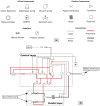Design and Fabrication of a Fully-Integrated, Miniaturised Fluidic System for the Analysis of Enzyme Kinetics
- PMID: 36984943
- PMCID: PMC10051508
- DOI: 10.3390/mi14030537
Design and Fabrication of a Fully-Integrated, Miniaturised Fluidic System for the Analysis of Enzyme Kinetics
Abstract
The lab-on-a-chip concept, enabled by microfluidic technology, promises the integration of multiple discrete laboratory techniques into a miniaturised system. Research into microfluidics has generally focused on the development of individual elements of the total system (often with relatively limited functionality), without full consideration for integration into a complete fully optimised and miniaturised system. Typically, the operation of many of the reported lab-on-a-chip devices is dependent on the support of a laboratory framework. In this paper, a demonstrator platform for routine laboratory analysis is designed and built, which fully integrates a number of technologies into a single device with multiple domains such as fluidics, electronics, pneumatics, hydraulics, and photonics. This facilitates the delivery of breakthroughs in research, by incorporating all physical requirements into a single device. To highlight this proposed approach, this demonstrator microsystem acts as a fully integrated biochemical assay reaction system. The resulting design determines enzyme kinetics in an automated process and combines reservoirs, three-dimensional fluidic channels, optical sensing, and electronics in a low-cost, low-power and portable package.
Keywords: fluidics; integrated devices; integration; lab-on-a-chip; miniaturised total analysis system; optofluidics; sensors.
Conflict of interest statement
The authors declare no conflict of interest.
Figures




Similar articles
-
Enabling miniaturised personalised diagnostics: from lab-on-a-chip to lab-in-a-drop.Lab Chip. 2017 Sep 26;17(19):3200-3220. doi: 10.1039/c7lc00587c. Lab Chip. 2017. PMID: 28850136 Review.
-
Portable and integrated microfluidic flow control system using off-the-shelf components towards organs-on-chip applications.Biomed Microdevices. 2023 Jun 2;25(2):19. doi: 10.1007/s10544-023-00657-z. Biomed Microdevices. 2023. PMID: 37266714 Free PMC article.
-
Subtractive Microfluidics in CMOS.Tech Dig Int Electron Devices Meet. 2024 Dec;2024:10.1109/iedm50854.2024.10873317. doi: 10.1109/iedm50854.2024.10873317. Tech Dig Int Electron Devices Meet. 2024. PMID: 40171331 Free PMC article.
-
Fully integrated microfluidic separations systems for biochemical analysis.J Chromatogr A. 2007 Oct 19;1168(1-2):170-88; discussion 169. doi: 10.1016/j.chroma.2007.06.010. Epub 2007 Jun 12. J Chromatogr A. 2007. PMID: 17659293 Review.
-
Heterogeneous Integration of CMOS Sensors and Fluidic Networks Using Wafer-Level Molding.IEEE Trans Biomed Circuits Syst. 2018 Oct;12(5):1046-1055. doi: 10.1109/TBCAS.2018.2845867. Epub 2018 Jul 16. IEEE Trans Biomed Circuits Syst. 2018. PMID: 30010595
Cited by
-
Graphene Oxide Paper Manipulation of Micro-Reactor Drops.Micromachines (Basel). 2023 Jun 26;14(7):1306. doi: 10.3390/mi14071306. Micromachines (Basel). 2023. PMID: 37512618 Free PMC article.
References
-
- Trietsch S.J., Hankemeier T., van der Linden H.J. Lab-on-a-chip technologies for massive parallel data generation in the life sciences: A review. Chemom. Intell. Lab. Syst. 2011;108:64–75. doi: 10.1016/j.chemolab.2011.03.005. - DOI
-
- Manz A., Graber N., Widmer H.M. Miniaturized total chemical analysis systems: A novel concept for chemical sensing. Sens. Actuators B Chem. 1990;1:244–248. doi: 10.1016/0925-4005(90)80209-I. - DOI
LinkOut - more resources
Full Text Sources
Miscellaneous

